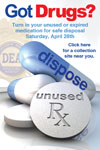
Participate in National Prescription Drug Take-Back Day. You could save a life.
In 2012, healthcare providers prescribed 259 million painkillers according to the Centers for Disease Control and Prevention (CDC) – enough medication for every American adult to have a bottle of pills. And this number only reflects pain medications, not other drug classes that usually go along with opioids and narcotics. Prescribers in the United States are writing prescriptions for three times more opioids than their Canadian counterparts. There are too many unused prescription drugs and they are getting into the wrong hands. According to the 2013 National Survey on Drug Use and Health conducted by the Substance Abuse and Mental Health Services Administration, 15.3 million people age 12 or older used prescription drugs for non-medical reasons.
National Prescription Drug Take-Back Day, established by the Drug Enforcement Administration (DEA), was created to help reduce prescription drug risks and encourage safety. Consider these statistics:
- Each day 46 people die from an opioid overdose with 90% of those deaths accidental.
- Every four minutes someone is in the emergency department due to opioid complications, including 5000 children.
- One-third of all new abusers of prescription drugs in 2006 were 12- to 17-year-olds.
As a result of increased prescription drug misuse among children, in 2010, the DEA amended its controlled substance laws to provide a safe, convenient and responsible way to dispose of prescription medications that are unwanted, unused or expired, while also educating the public on the potential for the abuse of medications. This act is known as The Secure and Responsible Drug Disposal Act of 2010. It allows patients to deliver unused pharmaceutical controlled substances to appropriate entities for disposal in a safe and effective manner consistent with effective controls against diversion. This law also allows long term care facilities to dispose of controlled substances on behalf of residents in their facility in the same manner, consistent with the public health and safety. This includes the ability of an authorized person to dispose of controlled substance prescriptions of a deceased patient. This take back program does not apply to the disposal of illicit drugs such as marijuana and heroin but only to pharmaceuticals prescribed by a healthcare provider.
Prescription medications, including controlled substances, can be found anywhere, ranging from old bottles in grandma’s medicine cabinet after her knee surgery to the floors of a hotel conference room. Just last week my colleague Dr. Paul Peak found a tablet on the floor while he was attending a conference in California. To the general public a tablet with an imprint of M360 may not mean much, but to him it was a red flag because the trade name of this medication is hydrocodone (Vicodin®), a schedule II controlled prescription.
Everyone must be accountable for the medications they are prescribed. As providers, we need to educate our patients about the safe disposal of unused and unwanted medications. Pain and other symptoms requiring prescriptions are often resolved before the entire prescription is used. More often than not a large proportion of those medications end up in the medicine cabinet or the kitchen drawer. Statistics prove that childproof drug packaging or top cabinet shelves are not enough to protect children and teenagers from an unintentional overdose. Parents, grandparents and caregivers need to be aware of the dangers of these medications.
Take this opportunity to educate injured workers on the safe disposal practices of unused medications. Saturday, September 26, 2015 is National Prescription Drug Take-Back Day. As claims examiners, nurses, pharmacists and physicians, it is our duty to promote awareness across the injured population about the correct disposal of prescribed medications. Throwing medications in the garbage or flushing them down the toilet is not only unsafe but also has a negative impact on the environment. Individuals can find their community medicine take-back locations by calling local law enforcement agencies. Medication disposal options and guidelines are also available locally through city or county government household trash and recycling services.
National Drug Take-Back Day is not just once a year. The DEA has sponsored nine previous Prescription Drug Take-Back Days, collecting almost two and a half tons of prescription medication. On September 26, various local sites will be set up to collect unused, unwanted or expired medications to provide safe and responsible disposal of pharmaceutical medications. We encourage you not only to help increase awareness of this program that helps reduce the risk created by stockpiles of prescription medications, but to take this opportunity to clean up your own medicine cabinet.
Reema Hammoud, PharmD, BCPS, Director Clinical Pharmacy Sedgwick